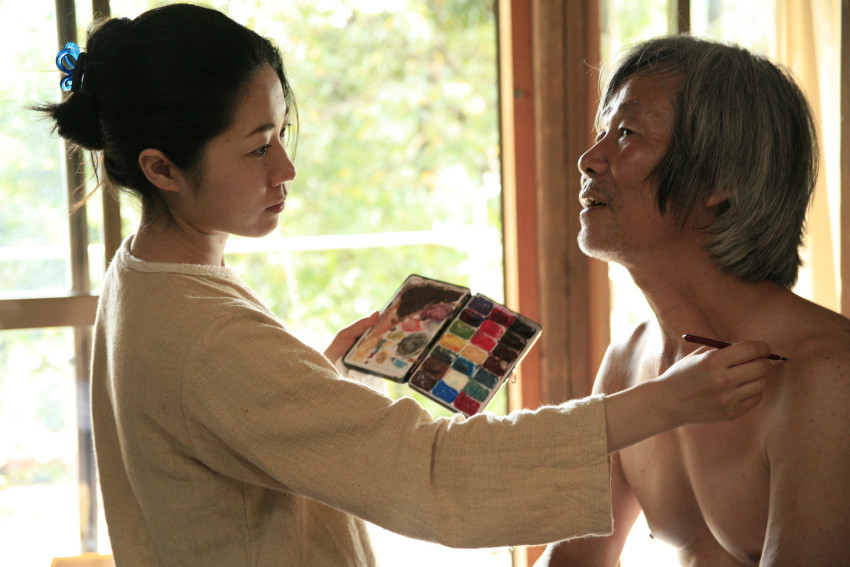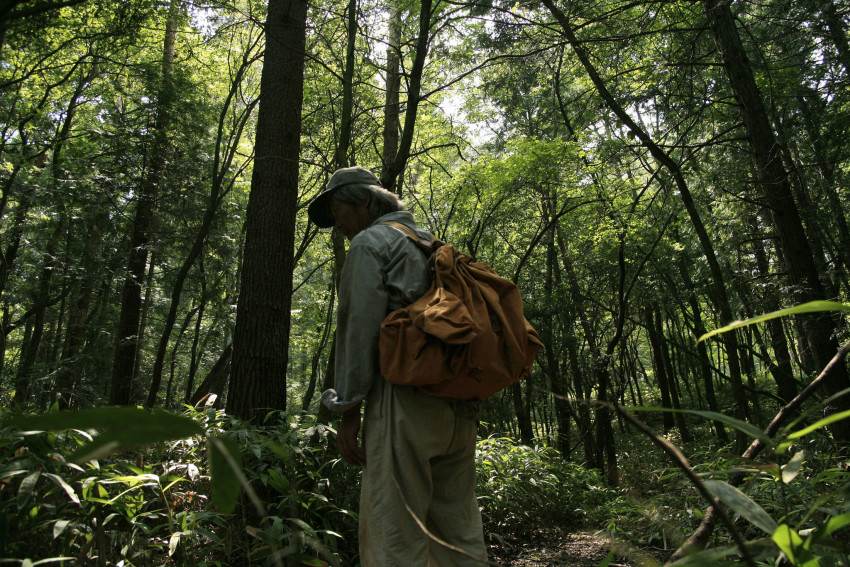The Mourning Forest
August 23, 2017 · 0 comments
by Jeremy Clarke.
 Wind. Trees. Tall grass. A road barely discernible but for the occasional top of a hedge. A fluttering, white banner of a funeral procession moves imperceptibly across the landscape, a futile ritual for an unknown person.
Wind. Trees. Tall grass. A road barely discernible but for the occasional top of a hedge. A fluttering, white banner of a funeral procession moves imperceptibly across the landscape, a futile ritual for an unknown person.
A room’s corner between two windows. Beyond them: wind and trees. Against the corner leans the sleeping Mr Shigeki (Shigeki Uda). The boss of this old people’s home Wakako (Makiko Watanabe) is showing new care worker Machiko (Machiko Ono) the ropes. “There are no rules here”, she tells her. Machiko is in emotional free-fall. At home, she lights a candle beside a photograph of a young boy. Berated by her husband for letting go of her child’s hand, Machiko has never got over the incident.
Machiko writes her name in a calligraphy class. Next to her Mr. Shigeki repeats the name “Ma-Ko” and inks out her middle syllable. It seems Mako was the name of his wife who died thirty-three years ago. He, too, has never quite got over his loss.
The Mourning Forest’s director Naomi Kawase is a master of understatement. There are key players in this drama we never or hardly ever see: the unknown person commemorated in the funeral procession; the late Mrs Shigeki who appears as a silent presence in the forest; Machiko’s missing son, glimpsed as no more than a framed photograph; and her husband who appears in a single scene and even then from behind, so we’ve no real idea of what he looks like.
A visiting Buddhist monk explores the question “Am I alive?” and tells Machiko to hold Mr Shigeki’s hand. Something happens to Shigeki. After climbing a tree he races around playing hide and seek with Machiko in nearby, cultivated fields. Later, she drives him out to the countryside but lands the car in a ditch. When she returns from seeking help, Mr Shigeki is gone. Following a frantic search she spots him and exhaustedly pursues the sprightly old man round a field only to finally catch up with him as he’s eating a melon. He stuffs handfuls of the fruit into her mouth. If she was about to admonish him for his bad behaviour, this disarms her.
The old man is clearly determined to walk somewhere and the pair set off into the forest. He falls into a stream. They get soaked in a rainstorm. For two days he searches for the tomb of his late wife. Machiko worries they’re going round in circles. A helicopter is heard overhead suggesting the authorities might be out looking for them. Through all this, the forest remains an inescapable presence. At the close the camera rises above the two main actors to leave us once again seeing nothing but environment. Trees blowing in the wind.
 Kawase’s films alternate between documentaries and fiction. Just as her later Sweet Bean utilises food preparation footage within a drama, so The Mourning Forest’s narrative is full of trees and green vegetation. Her documentarian side also comes through in the believable and convincing care-home scenes. The old people seem natural on the screen and it’s not clear how many are. That’s certainly the case with one of Kawase’s two leads here. Apparently, Shigeki Uda was a man she found in her local bookshop and thought would be perfect for the role (which he is).
Kawase’s films alternate between documentaries and fiction. Just as her later Sweet Bean utilises food preparation footage within a drama, so The Mourning Forest’s narrative is full of trees and green vegetation. Her documentarian side also comes through in the believable and convincing care-home scenes. The old people seem natural on the screen and it’s not clear how many are. That’s certainly the case with one of Kawase’s two leads here. Apparently, Shigeki Uda was a man she found in her local bookshop and thought would be perfect for the role (which he is).
Machiko Ono, on the other hand, is a seasoned actress Kawase discovered on her 1997 film Suzaku. Ono was more recently seen in Kore-eda’s Like Father, Like Son (2013). In The Mourning Forest, Ono’s professional and Shigeki’s non-professional performance complement each other well. Throughout the care home scenes, you’re never quite sure whether you’re watching real people in the manner of a documentary or actors in a fiction. This effect carries through in the two main performances to some extent although it’s arguably less effective in the latter, forest-based section as Machiko/Ono’s role becomes more prominent.
A curious mixture of joie-de-vivre and coming to terms with loss, The Mourning Forest derives its power from these down-to-earth performances while the ever-present trees and green vegetation lend a ‘back-to-nature’ feel not dissimilar to Miyazaki’s My Neighbour Totoro and that more recent Ghibli oddity The Red Turtle. It’s undeniably a work by someone who believes the natural world can work wonders on people. That was equally true of Sweet Bean’s food preparation scenes which suggested a heartfelt craft connected to the people involved rather than a soulless, industrial process.
The film really comes alive whenever its two protagonists interact with the landscape. Kawase might almost be constructing a visual film poem about the forest itself. Towards the finale, they find a gigantic tree bereft of leaves which Mr Shigeru respects as if it were a religious memorial to his departed wife. A briefly glimpsed summit promises more daylight, perhaps on a hilltop where the trees thin out. If this is an essay on death and loss, it’s an optimistic one emphasising the impact of nature and suggesting light at the end of the journey.
The Mourning Forest is released on Dual Format (Blu-ray & DVD) by Eureka Entertainment.
Leave a Reply